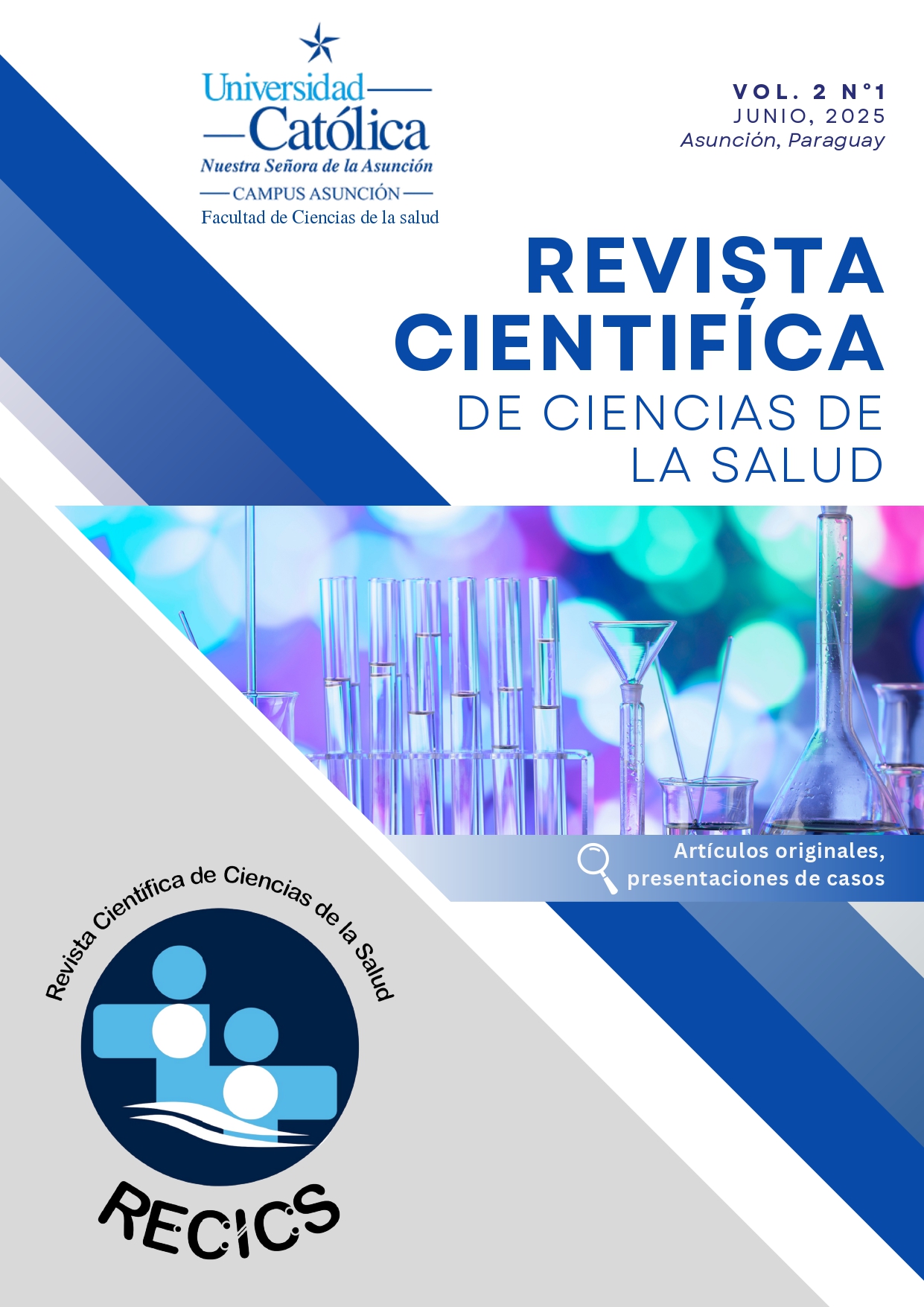Use of supplements, body composition and physical performance in first division soccer players of the National Club in 2023
Keywords:
Supplements, Body composition, Physical performanceAbstract
Objective: To describe supplement use, body composition, and physical performance in first division soccer players from the Nacional club in 2023. Methodology: An observational, descriptive, cross-sectional study was conducted involving 33 players with an average age of 25.2 years. A digital interview survey was conducted with three sections: sociodemographic data, supplement use, and physical activity. Body composition data were also recorded using the Indody bioimpedance scale. Results: 12.1% (n=4) were goalkeepers, 21.2% (n=7) were defenders, 18.2% (n=6) were forwards, and 48.5% (n=16) were midfielders. It was found that 51.5% (n=17) did not consume supplements, while 48.5% (n=16) did. 93.8% (n=15) consumed protein supplements, while 62.5% of the players consumed creatine. 56.3% (n=9) reported having consumed supplements for greater athletic performance, 43.8% (n=7) for better muscle development. Regarding the type of physical activity, the frequency of technical exercises was first analyzed, with 63.6% (n=21) reporting doing them six times a week. Secondly, the frequency of resistance-type exercises was analyzed, with 24.2% (n=8) reporting doing them twice a week and 39.4% (n=13) reporting doing them six times a week. The frequency of bodybuilding exercises was reported by 24.2% (n=8) to do it three times a week and 51.5% (n=17) six times a week. In terms of weight, 72.7% (n=24) were of normal weight, on the other hand, 27.3% (n=9) were of high weight, including 75% of the goalkeepers (n=3). In terms of fat percentage, 87.9% (n=29) of the players had a normal fat percentage. 6.1% (n=2) had a low fat percentage, of which 16.7% (n=1) were forwards and 6.3% (n=1) were midfielders. It was found that 6.1% (n=2) had a high fat percentage, of which the total 12.5% (n=2) were midfielders. Regarding total lean mass classification, 69.7% (n=23) had a high percentage of lean mass, of which midfielders had 75% (n=12), goalkeepers 75% (n=3), defenders 71.4% (n=4), and forwards 50% (n=3). On the other hand, 30.3% (n=10) had a normal percentage of lean mass, most of whom were forwards with 50% (n=3). Conclusion: Regarding the relationship between supplement use, body composition, and physical performance, a correlation was found between supplement use, high lean mass, and improved performance.
Downloads
References
1. Gil MA. Manual de nutrición deportiva (Color): Editorial Paidotribo; 2005.
2. Fernandes H. Dietary and Ergogenic Supplementation to Improve Elite Soccer Players' Performance. Annals of nutrition & metabolism. 2021;77(4):197-203.
3. Sebastiá-Rico J, Soriano JM, González-Gálvez N, Martínez-Sanz JM. Body composition of male professional soccer players using different measurement methods: A systematic review and meta-analysis. Nutrients
4. Hall M, Manetta E, Tupper K. Creatine Supplementation: An Update. Current Sports Medicine Reports. 2021;20(7):338-44.
5. Maughan RJ, Burke LM, Dvorak J, Larson-Meyer DE, Peeling P, Phillips SM, et al. IOC Consensus Statement: Dietary Supplements and the High-Performance Athlete. International journal of sport nutrition and exercise metabolism. 2018;28(2):104-25.
6. Peeling P, Castell LM, Derave W, de Hon O, Burke LM. Sports Foods and Dietary Supplements for Optimal Function and Performance Enhancement in Track-and-Field Athletes. International journal of sport nutrition and exercise metabolism. 2019;29(2):198-209.
7. Leão C, Camões M, Clemente FM, Nikolaidis PT, Lima R, Bezerra P, et al. Anthropometric Profile of Soccer Players as a Determinant of Position Specificity and Methodological Issues of Body Composition Estimation. International journal of environmental research and public health. 2019;16(13).
8. Villagra Collar PG, Medina Duarte ML, Rios S, Velázquez Comelli PC. Evaluación de la alimentación, composición corporal y rendimiento deportivo en jugadores profesionales de un club de primera división del futbol paraguayo. Rev. cient. cienc. salud [Internet]. 27 de abril de 2023 [citado 26 de noviembre de 2023; 5:1-7.
9. Kårlund A, Gómez-Gallego C, Turpeinen AM, Palo-Oja OM, El-Nezami H, Kolehmainen M. Protein Supplements and Their Relation with Nutrition, Microbiota Composition and Health: Is More Protein Always Better for Sportspeople? Nutrients. 2019;11(4).
10. Santander Ballestín S, Giménez Campos MI, Ballestín Ballestín J, Luesma Bartolomé MJ. Is Supplementation with Micronutrients Still Necessary during Pregnancy? A Review. Nutrients. 2021;13(9).
11. Campa F, Toselli S, Mazzilli M, Gobbo LA, Coratella G. Assessment of Body Composition in Athletes: A Narrative Review of Available Methods with Special Reference to Quantitative and Qualitative Bioimpedance Analysis. Nutrients. 2021; 13(5).
12. Chandel NS. Carbohydrate Metabolism. Cold Spring Harbor perspectives in biology. 2021; 13(1).
13. Kuriyan R. Body composition techniques. The Indian journal of medical research. 2018;148(5):648-58.
14. Savarino G, Corsello A, Corsello G. Macronutrient balance and micronutrient amounts through growth and development. Italian journal of pediatrics. 2021;47(1):109.
15. Holmes CJ, Racette SB. The Utility of Body Composition Assessment in Nutrition and Clinical Practice: An Overview of Current Methodology. Nutrients. 2021;13(8).
16. Spehnjak M, Gušić M, Molnar S, Baić M, Andrašić S, Selimi M, et al. Body Composition in Elite Soccer Players from Youth to Senior Squad. International journal of environmental research and public health. 2021; 18(9).
17. Miguel M, Oliveira R, Loureiro N, García-Rubio J, Ibáñez SJ. Load Measures in Training/Match Monitoring in Soccer: A Systematic Review. International journal of environmental research and public health. 2021;18(5).
18. Douchet T, Paizis C, Carling C, Cometti C, Babault N. Typical weekly physical periodization in French academy soccer teams: a survey. Biology of sport. 2023; 40(3): 731-40.
19. Sekulic D, Tahiraj E, Maric D, Olujic D, Bianco A, Zaletel P. What drives athletes toward dietary supplement use: objective knowledge or self-perceived competence? Cross-sectional analysis of professional team-sport players from Southeastern Europe during the competitive season. J Int Soc Sports Nutr. 2019;16(1):25.
20. Lago Y. Superando el mito de la fatiga en el fútbol. Influencia del tiempo efectivo de juego sobre la distancia recorrida por futbolistas de elite.
21. Madrid Quesada D. Importancia de la nutrición en el rendimiento deportivo y prevención de lesiones en el fútbol.






